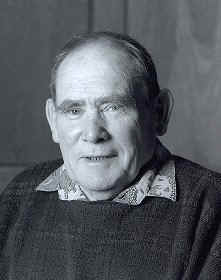
Sydney Brenner
(1927 - )
Sydney Brenner was born in Germiston, close to Johannesburg, to Jewish parents on 13 January 1927. His father was a shoe repairman who had moved to South Africa from Lithuania in 1910, while his mother had emigrated from Latvia in 1922. Although his father was illiterate he could speak English, Yiddish, Russian Afrikaans and Zulu.
Brenner was highly intelligent and learned to read at an early age. One of his father's customers convinced Mr. Brenner senior to allow Sydney to go to kindergarten at age 5. The young boy completed the first 3 years of his primary education in 1 year and entered Grade 4 when he was 6 years old. He moved on to Germiston High School where he matriculated in 1941, just before he turned 15. During this time he developed an active interest in chemistry. He collected test tubes and other equipment and soon became interested in biochemistry.
In 1942, at the age of 15, Brenner enrolled at the University of the Witwatersrand to study medicine. He was the first member of his family to pursue tertiary study. During his studies he developed and interest in cellular functions. It was clear that he would be to young to practice medicine on completion of his course and Brenner spent an additional year studying Anatomy and Physiology as part of a B. Sc. Medical course. He enjoyed this immensely and stayed on for 2 more years to complete an Honours Degree followed by a M. Sc.
Brenner published his first paper with co-writers Joe and Teddy Gillman in 1945, but his first solo paper appeared in 1946. The piece covered histochemical reaction. In the same year he was invited to work at the Department of Anatomy at Oxford. He decided to complete his course in South Africa and finally received his MB BCh. degrees in 1951. He knew that he wanted to continue his work overseas and, when he received a scholarship, was convinced to go to Oxford. He arrived at the institution in 1952 to complete a Ph. D. in Physical Chemistry Laboratory. This was where he met and married his wife, A South Africa who was doing a Ph.D. in Psychology in London. The couple and their two children remained there for 2 years.
In 1954 the couple returned to South Africa with the support of a Carnegie Corporation Fellowship awarded to Brenner. He set up a laboratory and began working on a way to solve genetic code. They returned to England when he was awarded a position at Cambridge's Medical Research Council (MRC) Unit. Brenner remained here for 20 years and pursued his interests in the human nervous system and brain construction.
In 1977 Brenner was assigned to becoming the Director of the MRC Laboratory in 1979. He became interested in genetics and the possible influence of new cloning and DNA sequencing techniques. He became an enthusiastic supporter of the Human Genome Sequencing Project. The administrative responsibilities associated with the position of Director became cumbersome and Brenner decided to leave his position in 1986. The MRC allowed him a small research unit, but this was closed down in 1992, but Brenner managed to keep it functional through outside sponsorship.
Brenner's health began to deteriorate and he decided to spend the winter in La Jolla, California. Here he helped develop a new method to sequence DNA. In 1995 he founded The Molecular Sciences Institute to promote the study of science. In 2000 he retired from the institute and was appointed a Distinguished Professor at the Salk Institute for Biological Studies in 2001.
In 2002 Brenner, H. Robert Horvitz and John E. Sulston were awarded the nobel Prize for Physiology or Medicine for their work on 'genetic regulation of organ development and programmed cell death'.
Courtesy of:
